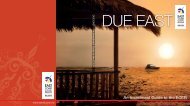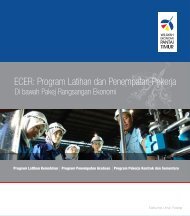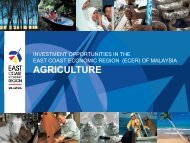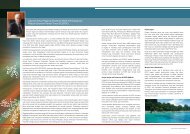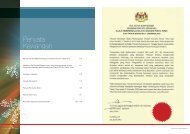TRANSFORMING THE EAST COAST ECER - Driving Development ...
TRANSFORMING THE EAST COAST ECER - Driving Development ...
TRANSFORMING THE EAST COAST ECER - Driving Development ...
You also want an ePaper? Increase the reach of your titles
YUMPU automatically turns print PDFs into web optimized ePapers that Google loves.
August 4, 2009<br />
<strong>ECER</strong> : DRIVING DEVELOPMENT, BALANCED GROWTH<br />
One year on, the <strong>ECER</strong> has notched several impressive milestones. As it moves into its second year of implementation, more benefits, both social<br />
and economic, can be expected to spillover to all of its 4 million people. The key now is believing that change is possible.<br />
The people of Malaysia’s east coast states have always<br />
basked in the natural beauty of their surroundings and<br />
enjoyed a tranquil lifestyle envied by other Malaysians<br />
and foreign visitors.<br />
The region’s beaches, resort islands, natural resources<br />
and unique cultural elements have made the states of<br />
Kelantan, Terengganu and Pahang, together with the<br />
district of Mersing in Johor, a haven for travellers from<br />
all over the world.<br />
This region, grouped today as the <strong>ECER</strong>, has much to<br />
offer in terms of richness in cultural diversity, and in<br />
the depth of its potential for development. The <strong>ECER</strong><br />
has become a key focus of the Government in ensuring<br />
that the Region acquires additional dimensions in<br />
keeping pace with development with the rest of the<br />
country.<br />
With an area measuring more than 66,000 sq km, the<br />
<strong>ECER</strong> covers 51 per cent of the land area of Peninsular<br />
Malaysia. The <strong>ECER</strong>’s population of about 3.9 million<br />
represents 14.5 per cent of the total population of<br />
Malaysia. By 2020, this will grow to over 4.9 million<br />
people, with a total workforce of about 2 million.<br />
Geographically, the <strong>ECER</strong> is also the strategic gateway<br />
to the vast markets of the Asia Pacific, with a total<br />
population of 2.2 billion.<br />
To guide the development of the Region, a Master<br />
Plan was developed, which was spearheaded by<br />
PETRONAS. It will transform the <strong>ECER</strong> into a major local<br />
and international tourism destination; an exporter of<br />
resource-based and manufactured products, a vibrant<br />
trading centre and an infrastructure and logistics hub.<br />
Ultimately, the vision for the <strong>ECER</strong> is to be a developed<br />
Region by 2020.<br />
Amongst the mission thrusts, the aim to eradicate<br />
hardcore poverty by 2010 within the <strong>ECER</strong> will be<br />
achieved by enabling the Region’s population to<br />
gain higher household incomes through sustainable<br />
livelihoods and increased job and entrepreneurial<br />
opportunities resulting from investment projects<br />
planned for the Region.<br />
The East Coast Economic Region<br />
“The most important objective of regional development is to achieve<br />
a balanced, focused regional growth by spreading economic<br />
development to embrace all states and regions. This is especially true<br />
for the east coast where tremendous opportunities await.”<br />
Y.A.Bhg. Tun Abdullah bin Haji Ahmad Badawi<br />
Advisor, Corridor <strong>Development</strong><br />
The envisaged development in the <strong>ECER</strong> will<br />
create up to 560,000 jobs by the year 2020. The<br />
target is to raise the average monthly household<br />
income from RM2,267 (2005) to RM5,227, and<br />
increase GDP per capita from RM5,860 (2005) to<br />
RM13,510 by 2020.<br />
The vision and mission that will guide the<br />
transformation of the <strong>ECER</strong> into a developed Region<br />
by 2020 is defined by three main characteristics –<br />
distinctive, dynamic and competitive.<br />
Projected Growth under the <strong>ECER</strong> Master Plan<br />
The distinctiveness of the <strong>ECER</strong> is portrayed<br />
through its natural beauty, abundant resources,<br />
unique culture and heritage known throughout the<br />
world. To maintain this characteristic, a balanced<br />
and sustainable development is emphasised.<br />
The dynamism of the <strong>ECER</strong> reflects the potential<br />
for the Region to grow and develop at a faster<br />
pace through innovation and a shift in economic<br />
orientation, structure, technology and mindset.<br />
The competitiveness of the <strong>ECER</strong> lies in its ability<br />
to attract local and foreign direct investments.<br />
2005 2020<br />
GDP growth (in %) 5.7% 7.2%<br />
GDP growth (in RM billion) RM23.1 RM65.9<br />
GDP per capita (in RM) RM5,860 RM13,510<br />
Average Monthly Household Income (in RM) RM2,267 RM5,227<br />
Total Population 3.9 mil 4.9 mil<br />
Projected Number of New Jobs Created 560,000<br />
PAGE 3<br />
With the prevailing economic conditions, the need<br />
to maintain the momentum of development within<br />
the <strong>ECER</strong> is seen to be very urgent. The Malaysian<br />
Government has thus chosen to fast-track the<br />
setting up of the next phase of the <strong>ECER</strong> Master<br />
Plan – the Special Economic Zone (SEZ).<br />
In essence, the <strong>ECER</strong> SEZ is a concentration<br />
of high-impact projects within an integrated<br />
development zone located at the nucleus of the<br />
<strong>ECER</strong> – the 25km by 140km strip that extends<br />
from Kertih in the north to Pekan in the south and<br />
Gambang in the west.<br />
While projects throughout the <strong>ECER</strong> will continue<br />
proceeding as planned, those located within<br />
the <strong>ECER</strong> SEZ will be boosted by the additional<br />
impetus of the unique privileges and exclusive<br />
incentives accorded to a special economic zone,<br />
in order to accelerate development.<br />
A notable emphasis is that while the country has<br />
made significant strides in developing the national<br />
economy, the <strong>ECER</strong> needs to catch up economically<br />
with the more developed parts of the country.<br />
Although overall progress and development is<br />
sought, it should not come at a price. All <strong>ECER</strong><br />
projects are carefully evaluated to determine their<br />
viability, not only in terms of improving lives but<br />
also from the aspect of sustainability on both the<br />
financial and environmental fronts.<br />
The <strong>ECER</strong> therefore employs a holistic approach<br />
that will ensure responsible development, as<br />
well as preserve the integrity of the environment<br />
for present and future generations. As such, it<br />
is important for all to ensure that all identified<br />
projects are carried out without any delay.<br />
Only by uniting and believing that change is<br />
possible can the Region be transformed into<br />
one that is dynamic and competitive, in the face<br />
of greater regional and global competition and<br />
economic liberalisation.




